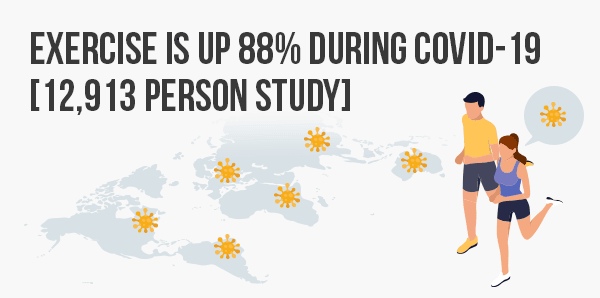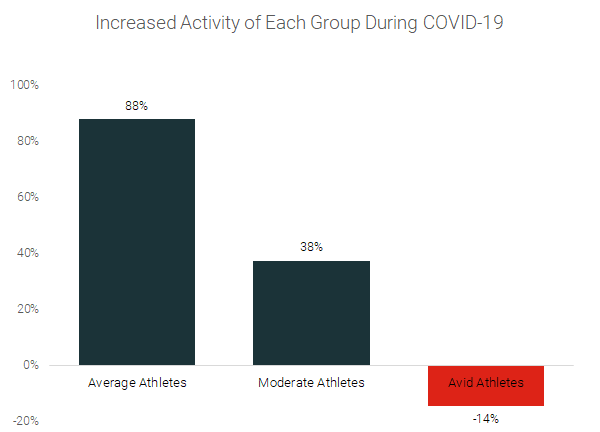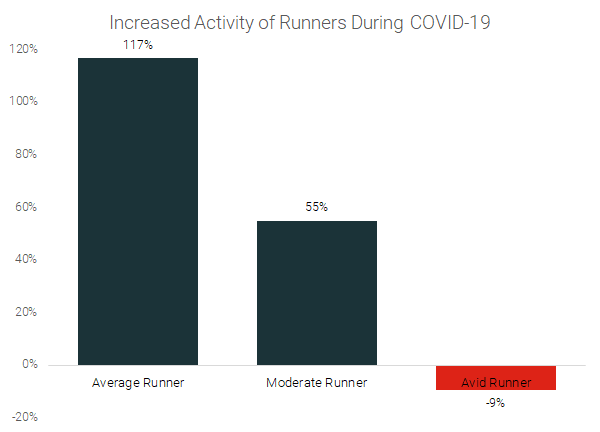Exercise is Up 88% During COVID-19 [12,913 Person Study]

The world is in crisis because of the COVID-19 pandemic. Between government lockdowns, layoffs, furloughs, work from home mandates, school closures, and sports facility shutdowns, we wanted to understand how this virus is affecting the exercise habits of people around the globe.
We surveyed 12,913 participants from 139 countries between March 24th and March 30th to gather data on how Coronavirus has changed their physical activity routines. Surprisingly, people are exercising at a greater frequency than before the pandemic became a global crisis.
Key Results
- People who normally exercise up to 1-2 times/week have increased exercising by 88% on average
- People who normally exercise up to 3 times/week have increased exercising by 38% on average
- People who normally exercise 4+ times/week have decreased exercising by 14% on average
RunRepeat pandemic related studies
At RunRepeat, we've been interested in understanding how COVID and this pandemic has effected sport, exercise, and health. Here are other studies we've published:
- Gyms Reopening: 46.67% of Members Won’t Return [Study]
- Quarantine Weight Gain: 35.82% Gained Weight During Pandemic [19,903 Person Study]
- Fitness Trends: Achieving fitness goals in 2021 vs 2020
Exercise habit changes during COVID-19
We asked participants to report on how many times a week they typically exercised, worked out, or played sports both before the outbreak, and after the outbreak hit a global scale.
For this study, we’ve defined multiple groups depending on their weekly frequency of exercise.
- Average Athlete: 1-2 times a week
- Moderate Athlete: up to 3 times a week
- Avid Athlete: 4+ times a week
Surprisingly, average athletes or those that normally only exercise 1-2 times a week increased their exercise frequency the most at 88% on average. Moderate athletes also increased their frequency by 38% on average.
Avid athletes, those that workout 4+ times a week, have decreased their exercise frequency by 14% on average.

Below you can see a further breakdown of each level of physical activity. Those that normally exercise just one time a week increased their exercise frequency by 156% to 2.56 times/week.
The biggest decreases in exercise frequency were seen from those that normally exercise 5 or 6 times a week.
| Activity Before COVID-19 (Times/Week) | Activity During COVID-19 (Times/Week) | Change in Activity |
| 1 | 2.56 | 156% |
| 2 | 3.10 | 55% |
| 3 | 3.25 | 8% |
| 4 | 3.62 | -10% |
| 5 | 4.22 | -16% |
| 6 | 4.95 | -18% |
| 7 | 5.96 | -15% |
Running specific data
One interesting trend was that of runners specifically. Running has remained one of the activities allowed for those on lockdown in most places
Again, the trend follows, with runners who normally only participate once or twice a week increasing their participation by 117% on average. Those previously running up to 3 times a week, reported an increase of 55% on average.
Avid runners (those running 4+ times a week) actually decreased their efforts by 9% on average because of the COVID-19 crisis.

Broken down further, you can see how each group has independently reacted to the pandemic. Those used to getting running the least, upped their efforts the most and those used to runner frequently decreased their efforts.
| Activity Before COVID-19 (Runs/Week) | Activity During COVID-19 (Runs/Week) | Change in Activity |
| 1 | 3.05 | 205% |
| 2 | 3.52 | 76% |
| 3 | 3.66 | 22% |
| 4 | 3.91 | -2% |
| 5 | 4.52 | -10% |
| 6 | 5.25 | -13% |
| 7 | 6.22 | -11% |
Data and methodology
- We surveyed 12,913 participants between 3/24/2020 and 3/30/2020
- 139 countries participated in the survey
- The survey was conducted on RunRepeat.com and available to all traffic
Exercising during the COVID-19 pandemic
Although many places around the world are under shelter-at-home orders, the majority of those orders allow for people to experience the benefits of exercise by getting active otudoors.. Running and walking around town are still great options. RunRepeat can help you find the right trail running shoes, road running shoes, training footwear, or trainers to ensure that this crisis doesn’t keep you from staying healthy.
RunRepeat covers more than just running and training as well, if you’re close to the trails hiking boots and shoes may help you safely stay active throughout the Corona pandemic. We buy all the shoes with our own money, we test them properly on the run/hike, and we test them in our in-house lab. There, all the shoes are cut in half and tested using durometers, force gauge, callipers, smoke machine, Dremel. This allows us to publish 20+ parameters for each shoe and keep the level of objectivity in reviews at the maximum.
Be sure to check out our in-depth studies on the sports we love and learn more about RunRepeat today.
Use of content
- We are happy to give interviews on the topic at any time. For this purpose or for print-use questions, or access to our raw data please reach out to Paul Ronto at paul@runrepeat.com.
- Feel free to use material from this page in any web coverage of the topic, we just ask that you refer, and link, back to this original source.
